AMD Announces Project SkyBridge: Pin-Compatible ARM and x86 SoCs in 2015, Android Support
by Anand Lal Shimpi on May 5, 2014 12:45 PM EST
This morning AMD decided to provide an update on its CPU core/SoC roadmap, particularly as it pertains to the ARM side of the business. AMD already committed to releasing a 28nm 8-core Cortex A57 based Opteron SoC this year. That particular SoC is aimed at the enterprise exclusively and doesn't ship with an on-die GPU.
Next year, AMD will release a low-power 20nm Cortex A57 based SoC with integrated Graphics Core Next GPU. The big news? The 20nm ARM based SoC will be pin compatible with AMD's next-generation low power x86 SoC (using Puma+ cores). The ARM SoC will also be AMD's first official Android platform.
I don't expect we'll see standard socketed desktop boards that are compatible with both ARM and x86 SoCs, but a pin compatible design will have some benefits for embedded, BGA solutions. AMD expects to target embedded and client markets with these designs, not servers.
AMD's motivation behind offering both ARM and x86 designs is pretty simple. The TAM (Total Addressable Market) for x86 is decreasing, while it's increasing for ARM. AMD is no longer married to x86 exclusively and by offering OEMs pin compatible x86/ARM solutions it gets to play in both markets, as well as benefit if one increases at the expense of the other.
Note that we're still talking about mobile phone/tablet class CPU cores here (Cortex A57/Puma+). AMD has yet to talk about what it wants to do at the high end, but I suspect there's a strategy there as well.












34 Comments
View All Comments
Silma - Tuesday, May 6, 2014 - link
The big guys like Apple and Samsung do their ARM themselves, the small guys buy from Qualcomm and Nvidia or can even work directly with TSMC.gruffi - Tuesday, May 6, 2014 - link
"AMD hasn't produced a single interesting processor in years."That's funny. I always think the same about Intel. I actually wanted to buy Haswell. But even this one is uninteresting for me.
Gizmosis350k - Wednesday, May 7, 2014 - link
What does this mean for enthusiast desktop processors? Will we have to wait until 2017 before the FX refresh is out?Cpuhog - Monday, May 12, 2014 - link
Can someone explain what the whole point is? They are not doing a dual architecture on the same chip. They are coming out with a low end ARM processor which will be pin-compatible with a low end x86 processor. At the high end they already have x86 offerings and now they will also have an ARM K12 based design. It does not appear that they have a good handle on how ARM is going to help them. They know they can't compete with x86 so how will they compete with ARM?